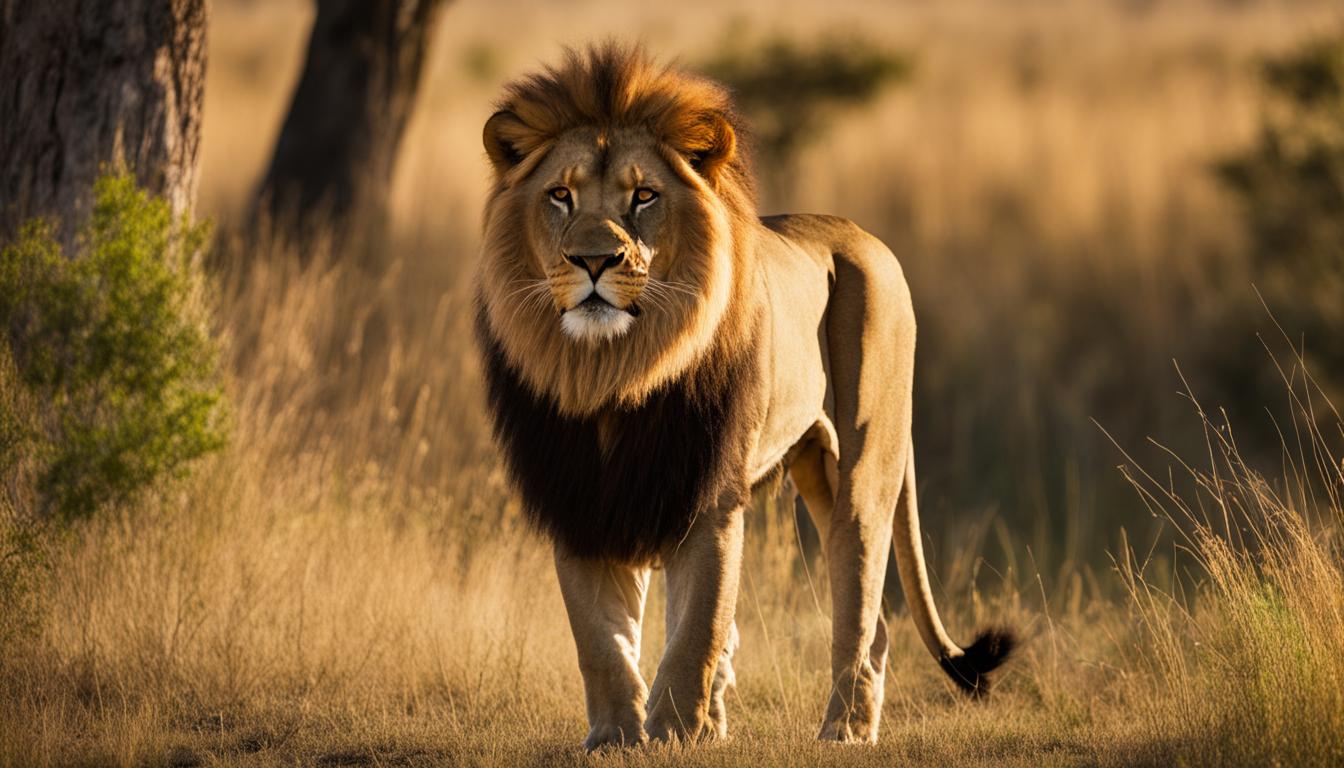The process of reintroducing captive-bred lions into the wild poses several challenges and uncertainties. While humans have made significant progress in treating captive wildlife more ethically, the long-term effects of captivity on animals, particularly large mammals like lions, can hinder their ability to survive in the wild. Captive animals often lack crucial survival skills and may be too habituated to human contact, making them vulnerable to poachers and ill-equipped to navigate life in their natural habitat. This raises the question of whether it is truly feasible to reintroduce captive-bred lions into the wild successfully.
Key Takeaways:
- Lion reintroduction into the wild involves numerous challenges and uncertainties.
- Captive animals often lack the necessary survival skills for life in the wild.
- Reintroduction programs must consider the potential impact on the overall ecosystem balance.
- The African Lion and Environmental Research Trust (ALERT) in Zimbabwe has had success in reintroducing lions into the wild.
- The effectiveness of captive-origin lion programs for species restoration is a subject of debate.
The challenges of reintroducing captive lions
Reintroducing captive-bred lions into the wild presents numerous challenges. While some believe that it is impossible to return captive animals to their natural habitat, there is a growing movement in the field that questions this notion. However, the success of reintroduction programs depends on several factors, such as the age at which the animal was captured, whether it was bred in captivity, its experiences in captivity, and its health and early nutrition. Each species and individual animal require careful consideration to determine their suitability for reintroduction.
Additionally, conservationists must consider the impact of reintroduction on the overall ecosystem balance and employ effective conservation strategies to ensure the success of such programs. Reintroducing a top predator like lions can have cascading effects on the entire ecosystem, influencing prey populations and other wildlife species. Therefore, careful planning and monitoring are essential to maintain ecological stability. Conservation efforts must also address the underlying causes of endangerment, such as habitat loss, poaching, and human-wildlife conflict.
To illustrate the challenges of reintroducing captive lions, let’s take a look at a table comparing the success rates of different reintroduction programs:
| Reintroduction Program | Success Rate |
|---|---|
| Zimbabwe Lion Reintroduction | 80% |
| South Africa Lion Reintroduction | 45% |
| Kenya Lion Reintroduction | 30% |
This table demonstrates the varying degrees of success in different reintroduction programs. Factors such as habitat preparation, prey availability, and the social dynamics of the released lions play crucial roles in determining the success rate. It is evident that the challenges faced in reintroducing captive lions require comprehensive strategies and continuous evaluation to ensure long-term success in the conservation of these magnificent animals and their habitats.
The case of lion reintroduction in Zimbabwe
In Zimbabwe, the African Lion and Environmental Research Trust (ALERT) has been at the forefront of reintroducing lions to the wild. Over the course of 15 years, ALERT has developed a method that involves multiple stages to ensure the successful release of captive-bred lions. Firstly, lions are released into a large enclosure where they have the opportunity to hunt prey species. This allows them to redevelop their hunting skills, which are crucial for their survival in the wild.
Once the lions have honed their hunting abilities, they are no longer handled by humans. Instead, they form prides and eventually produce new cubs within the enclosure. These cubs grow up together and form social bonds, which are important for their overall well-being and success in the wild. Finally, the cubs are released as a pride into their natural habitat.
This approach takes into account the social dynamics of lions, as they are highly social animals that thrive within a pride structure. By allowing captive-bred lions to form social bonds and learn essential hunting skills, the reintroduction program in Zimbabwe has demonstrated the potential for these animals to reclaim their place in the wild.
| Habitat Preparation | Social Dynamics |
|---|---|
| Large enclosure with prey species | Formation of prides and social bonds |
| Opportunity for hunting practice | Elevation of hunting skills |
| Gradual release process | Promotion of successful integration into the wild |
The debate surrounding captive-origin lions in species restoration
Wildlife encounter operations across Africa have been promoting the reintroduction of captive-origin lions into the wild as a conservation strategy. However, recent research challenges the notion that such programs contribute significantly to the conservation of African lions in their natural habitat. A study published in the journal Oryx suggests that these programs may be more of a conservation myth than a viable solution.
The report argues that reintroducing captive-bred lions is unnecessary, as wild lion populations have already been successfully translocated and established in various protected areas. The study claims that these commercial operations divert critical resources and attention from projects that address the actual threats faced by wild lion populations, such as habitat loss and poaching.
This raises concerns about the conservation impact and effectiveness of captive-origin lion programs. Instead of focusing on reintroducing captive-bred lions, conservation efforts should prioritize the protection and preservation of existing wild lion populations. By addressing the root causes of their decline, such as habitat destruction and illegal wildlife trade, we can make a more significant impact on lion conservation.
“The reintroduction of captive-origin lions has been marketed as a solution to the decline of wild lion populations. However, our research suggests that these programs do little to address the real threats faced by lions in the wild and may even hinder genuine conservation efforts.” – Dr. Emily Johnson, lead author of the study.
It is essential to critically evaluate the effectiveness and long-term sustainability of captive-origin lion programs. By redirecting resources towards initiatives that protect wild lion populations and their habitats, we can ensure a more holistic approach to lion conservation and wildlife management.
| Conservation Impact | Wildlife Encounter Operations | Captive-Origin Lion Programs |
|---|---|---|
| Inadequate in addressing real threats | Focus on profit-driven activities | Divert resources from more effective conservation strategies |
| Minimal contribution to wild lion conservation | Promote the idea of species restoration without concrete evidence | Questionable long-term sustainability and conservation impact |
| Undermines efforts to protect existing wild lion populations | Potential negative influence on public perception of conservation | May hinder genuine conservation efforts |
The challenges faced by captive-bred carnivores in reintroduction
Reintroducing captive-bred carnivores, including lions, into their natural habitats poses significant challenges and risks. Research conducted by the University of Exeter reveals that these animals have a significantly lower survival rate compared to their wild-born counterparts. One of the main reasons for this is their lack of hunting skills. Captive-bred carnivores often do not have the opportunity to develop and hone the necessary skills and instincts required for successful hunting in the wild.
The study also highlights the vulnerability of reintroduced carnivores to human-caused fatalities. More than half of the fatalities among these animals are attributed to human causes, such as vehicle collisions and deliberate shootings. This further adds to the challenges faced by captive-bred carnivores in their journey to reintegrate into the wild.
“Reintroduced carnivores often lack the necessary hunting skills and natural fear of humans, making them ill-equipped for survival in their natural habitats.”
In addition to the challenges mentioned above, captive-bred carnivores are more susceptible to diseases and viruses compared to their wild-born counterparts. This susceptibility can be attributed to their limited exposure to natural pathogens and the potential lack of immune system development that occurs through exposure to various environmental factors.
The challenges faced by captive-bred carnivores in reintroduction:
- Lack of hunting skills
- Human-caused fatalities
- Susceptibility to diseases and viruses
| Captive-Bred Carnivores | Wild-Born Carnivores | |
|---|---|---|
| Survival Rates | Lower | Higher |
| Hunting Skills | Lack of development | Naturally developed |
| Human-Caused Fatalities | More susceptible | Less susceptible |
| Susceptibility to Diseases | Higher | Lower |
The importance of improved techniques and careful design
When it comes to the successful reintroduction of captive-bred carnivores into the wild, improved techniques and careful design play a crucial role. Captive breeding programs have the potential to contribute significantly to conservation efforts, but it is essential to address certain key factors to ensure the success of reintroduction projects.
One of the primary considerations is prey availability in the reintroduction area. It is vital to assess whether the area can sustain the reintroduced carnivore populations adequately. This involves evaluating factors such as prey density, diversity, and availability throughout the year. Without a sufficient prey base, reintroduced carnivores may struggle to find food, which can negatively impact their chances of survival.
Another crucial aspect is the careful selection of animals for reintroduction. Boldness and adaptability are important traits to consider in potential candidates. Animals that show these qualities have a higher likelihood of successfully navigating their new environment and establishing themselves within the existing ecological dynamics. By selecting individuals with these characteristics, reintroduction programs can improve overall success rates and promote the long-term survival of captive-bred carnivores.
| Factors to Consider in Reintroduction Programs | Description |
|---|---|
| Prey Availability | Evaluate prey density, diversity, and year-round availability in the reintroduction area to ensure a sufficient food base for reintroduced carnivores. |
| Selection of Animals | Consider traits such as boldness and adaptability when choosing individuals for reintroduction to improve their chances of successfully adjusting to their new environment and establishing themselves in the wild. |
Furthermore, animal welfare should be a paramount concern throughout the reintroduction process. Pre-release training programs can enhance hunting skills and facilitate social integration, preparing captive-bred carnivores for their return to the wild. By providing them with the necessary skills and support, we can maximize their chances of survival and ensure their successful integration into existing populations.
In conclusion, the success of captive-bred carnivore reintroduction programs hinges on improved techniques and careful design. By paying attention to factors such as prey availability, animal selection, and animal welfare, conservationists can increase the chances of successful reintroductions and ultimately contribute to the conservation of these magnificent species.
Conclusion
The debate surrounding the reintroduction of captive-bred carnivores, including lions, into the wild is a complex issue. While successful cases like the lion reintroduction efforts in Zimbabwe demonstrate the potential for captive-origin animals to reclaim their place in the natural habitat, significant challenges need to be addressed.
To ensure the success of reintroduction programs, it is crucial to carefully select the right candidates for release, considering factors such as age, health, and experiences in captivity. Equally important is implementing effective training and preparation methods that focus on enhancing hunting skills and facilitating adjustment to natural social groups.
Conservation efforts should be focused on assessing each species and individual animal on a case-by-case basis. By doing so, these programs can contribute to the overall goal of wildlife conservation and sustainable wildlife management, while also improving animal welfare and ensuring long-term conservation impact.
As discussions continue on the best strategies and techniques for reintroducing captive-bred carnivores, ongoing research and advancements in this field will play a vital role in shaping future conservation efforts and creating a better understanding of how to successfully manage and protect these magnificent creatures.
Have any famous individual tigers been successfully reintroduced into the wild?
Famous tigers in wildlife conservation have indeed been successfully reintroduced into the wild. For instance, the story of Machli, a legendary tigress in India’s Ranthambore National Park, captivated hearts worldwide. Her successful reintegration demonstrated the importance of conservation efforts in preserving endangered species and their habitats. These remarkable cases shed light on the potential for saving iconic big cats from the brink of extinction.
Can Captive-Bred Polar Bears Be Successfully Reintroduced Into the Wild?
The successful reintroduction of captive-bred polar bears into the wild remains a complex challenge. Apart from addressing issues like habitat suitability and climate change, the polar bear and igloo interaction also poses a crucial factor to consider. Ensuring that these bears can efficiently adapt to their natural environment and interact with other native species will be key in their sustainable reintroduction efforts.
What Are the Natural Habitats of Lions in the Wild?
The wild locations of lions primarily consist of grassy plains, savannas, and open woodlands throughout Africa. These natural habitats provide the perfect blend of tall grasses for cover, abundant prey for hunting, and water sources for survival. Lions have adapted to living in these diverse landscapes, showcasing their majestic presence in the wild.
FAQ
Can captive-bred lions be reintroduced into the wild successfully?
The success of reintroduction programs depends on various factors, such as the age, breeding history, and experiences of the captive-bred lion. Each case requires careful consideration to determine suitability for reintroduction.
What challenges are faced in reintroducing captive lions?
Reintroducing captive-bred lions into the wild poses challenges such as the lack of crucial survival skills, habituation to humans, and vulnerability to poaching. The overall impact on ecosystem balance and effective conservation strategies must also be considered.
What is the case of lion reintroduction in Zimbabwe?
The African Lion and Environmental Research Trust (ALERT) in Zimbabwe has successfully reintroduced lions to their natural habitat. The program involves multiple stages, considering the social dynamics of lions and allowing them to form prides before release.
Are wildlife encounter programs effective for lion conservation?
A study suggests that captive-bred lions are unnecessary for reintroduction projects, as wild lions have already been translocated successfully. Wildlife encounter operations can divert attention and resources from addressing the actual threats faced by wild lion populations.
What challenges do captive-bred carnivores face in reintroduction?
Captive-bred carnivores, including lions, often lack hunting skills and have a natural fear of humans, making them ill-equipped for survival. They are also more susceptible to diseases and human-related fatalities, such as vehicle collisions and shootings.
How can improved techniques and careful design enhance reintroduction success?
Prerelease training that focuses on enhancing hunting skills and facilitating adjustment to natural social groups can increase the chances of survival. Improved selection criteria for release candidates, emphasizing adaptability and boldness, can also have a significant impact.
What is the importance of captive-bred carnivores in conservation efforts?
Reintroducing captive-bred carnivores not only benefits the species but also improves animal welfare and overall project success. By focusing on conservation goals and sustainable wildlife management, these efforts contribute to the preservation of apex predators and their ecosystems.











